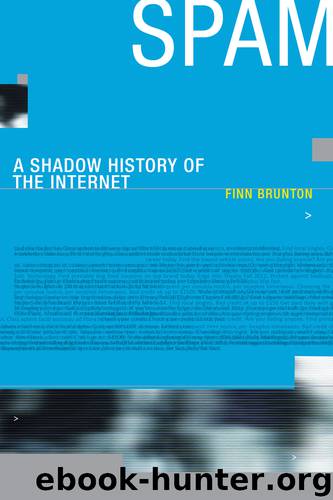Spam by Finn Brunton

Author:Finn Brunton [Brunton, Finn]
Language: eng
Format: epub
ISBN: 9780262313957
Publisher: MIT Press
Published: 2013-06-14T16:00:00+00:00
3 The Victim Cloud: 2003–2010
Filtering: Scientists and Hackers
Making Spam Scientific, Part I
We have machines capable of reading, analyzing, judging any written text. But it is precisely the reliability of the instruments on which we must run some checks.
—Italo Calvino, If on a Winter’s Night a Traveler
If you can’t get to grips with the spammers using law, censure, and protest, can you instead get to grips with spam itself? How do you get a handle on it, and how do you make it something you can measure and quantify, talk about coherently, understand—and therefore attack? It is an etymologically restless thing, at once noun and verb, that thrives wherever we have trouble defining it clearly enough to exclude it and make precise rules and laws for it. It is the subjective nemesis of the equally subjective germane human interaction. How do you turn it into a material you can work on? How do you make spam an object?
These are matters of practical interest for those seeking to analyze spam and make it something they can stop. This is a story about two such groups—scientists and hackers—and how they went about drawing lines around spam, defining edges and black boxes and criteria and workflows and making it into something to which they could apply tools. This is also necessarily a story about everything left out of the lines they drew, and how in changing the shape of spam it eluded them and transformed, both as a technology and as a set of practices, into something far stranger than before: a new object with a new infrastructure behind it, produced by a new class of criminals.
Spam comes into a computer lab with as much of a halo of strangeness as a chunk of cavorite—H. G. Wells’s fantasy material that resists gravity, with which scientists fall up to the moon—and with similarly strange and innovation-demanding effects. After all, what is this human-machine, innovative-criminal, social-technological, maddening yet unstoppable thing? It’s a practice, and a communally expressed attitude, but also an artifact of sorts, something that exists in the singular and ostensive—a “spam message,” this spam—but that also demands analysis in the plural as spam, the problem, on a larger scale. How do you specify this concept, making it productive of reproducible and falsifiable results that are capable of being benchmarked and tested? Spam is constantly fluctuating; the amount you receive depends on your ISP, what filters your ISP uses, your operating system and mail application, the number and type of the accounts that you use, and even the season and the time of day.1 Spam may seem at first like an ideal subject for scientific testing, as you do not even need to go to the trouble of collecting fruit flies or putting up a telescope to get material—just create an email account and watch it roll in! The infrastructure of spam is so complex, however, that simply testing the result of any given email account is like
Download
This site does not store any files on its server. We only index and link to content provided by other sites. Please contact the content providers to delete copyright contents if any and email us, we'll remove relevant links or contents immediately.
Mastering Bitcoin: Programming the Open Blockchain by Andreas M. Antonopoulos(3004)
Dawn of the New Everything by Jaron Lanier(2751)
Blockchain: Ultimate Step By Step Guide To Understanding Blockchain Technology, Bitcoin Creation, and the future of Money (Novice to Expert) by Keizer Söze(2465)
Alibaba by Duncan Clark(2054)
Foundations of Blockchain by Koshik Raj(1964)
Owning Bitcoin: The Illustrated Guide to Security, Privacy, and Potential by Apodaca Richard(1952)
Significant Zero by Walt Williams(1946)
The Mastermind by Evan Ratliff(1914)
Mastering Blockchain by Imran Bashir(1845)
Bitcoin: The Basics of Blockchain and Investing in Cryptocurrency by K. Connors(1793)
Bitcoin: The Ultimate Guide to the World of Bitcoin, Bitcoin Mining, Bitcoin Investing, Blockchain Technology, Cryptocurrency (2nd Edition) by Ikuya Takashima(1674)
Attack of the 50 Foot Blockchain by David Gerard(1664)
Turing's Cathedral by George Dyson(1645)
The Bitcoin Standard: The Decentralized Alternative to Central Banking by Saifedean Ammous(1644)
Cryptocurrency by Neil Hoffman(1621)
Shaping the Fourth Industrial Revolution by Klaus Schwab & Nicholas Davis & Satya Nadella(1608)
Dawn of the New Everything: Encounters with Reality and Virtual Reality by Jaron Lanier(1595)
The Bitcoin Guidebook by Ian DeMartino(1594)
Bill Gates by Michael Becraft(1546)
